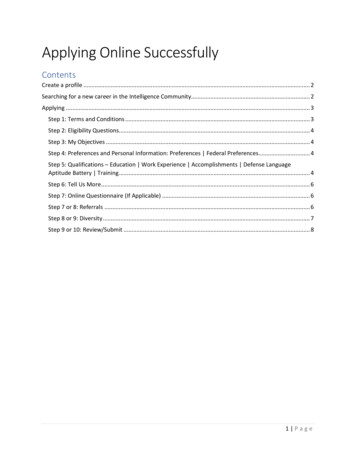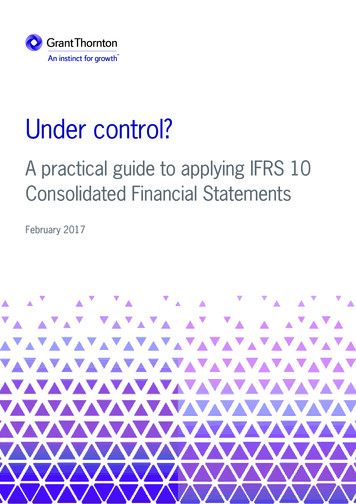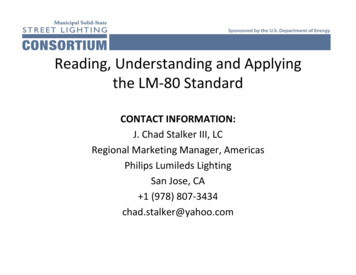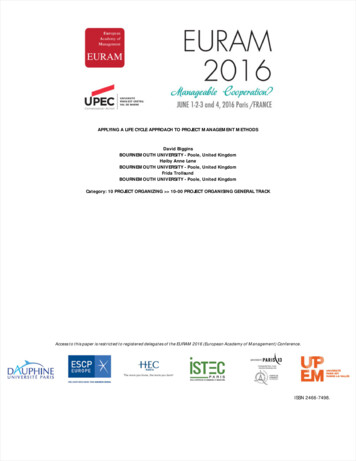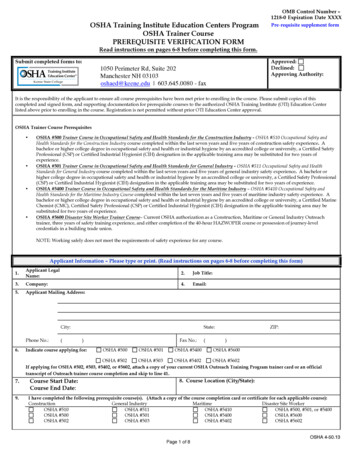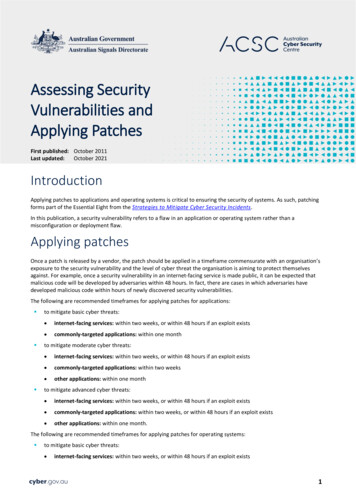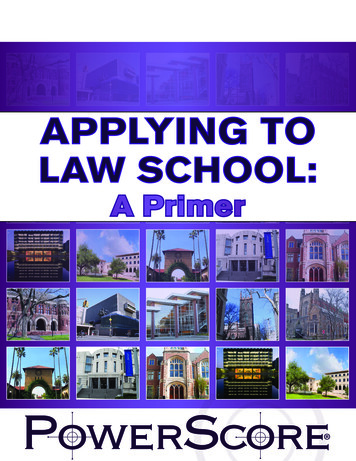
Transcription
APPLYING TOLAW SCHOOL:A Primer
Copyright 2011 by PowerScore Incorporated.All Rights Reserved. No part of this publication may be reproduced, stored in a retrieval system, ortransmitted in any form or by any means electronic, mechanical, photocopying, recording, scanning, orotherwise, without the prior written permission of the Publisher. Parts of this PDF have been previouslypublished in other PowerScore publications and on the powerscore.com website.PowerScore is a registered trademark. The Logical Reasoning BibleTM, The Logic Games BibleTM, TheReading Comprehension BibleTM , and the LSAT Bible SeriesTM are the exclusive service marked propertyof PowerScore. Any use of these terms without the express written consent of PowerScore is prohibited.LSAT, LSAC, and CAS are registered trademarks of Law Services.Published byPowerScore Publishing, a division of PowerScore Incorporated57 Hasell StreetCharleston, SC 29401Published in the United StatesSeptember 2011PowerScore Test Preparation
PowerScoreApplying to Law School: A PrimerSo, you’re applying to law school. Congratulations! Now that the decision has been made, youneed to get started with your applications.For many students, applying to law school can feel like an impenetrable maze filled with manynooks and crannies, but it doesn’t have to be that way. This primer is designed to give youa rundown of what you need to do in order to get your law school applications completedthoroughly and efficiently, and submitted to law schools at the best time.Let’s start with the basics.Five Steps to Applying to Law SchoolThe law school application process can be broken down into five steps:Step One: Taking the LSATStep Two: Picking Law SchoolsStep Three: Working On Your ApplicationsStep Four: Submitting Documents to LSACStep Five: Sending Your Application to Law SchoolsLet’s talk about each step in more detail.Applying to Law School: A Primer1
Step One: Taking the LSATSo, what is the LSAT? The LSAT is the Law School Admission Test. It is the testrequired for admission by all U.S. law schools accredited by the American BarAssociation (ABA), and by most law schools in Canada.Begin by checking out Getting Started with the LSAT, our starter’s guide to thetest. That will give you a solid introduction to what you need to know about it.Start by selecting the date on which you will take the test. The LSAT isadministered four times a year: February, June, September/October, andDecember. When it comes to choosing when you’ll take the test, eachadministration has its pros and cons.JUNE LSATThe June LSAT is a great option if you want to submit yourapplications in September, at the start of the admissions cycle.2 PRO: Taking this LSAT gives you the ability to submit yourapplication at the very start of the admission cycle, in midSeptember or early October, which is a huge advantage. PRO: If you don’t do as well as you’d like on the June LSAT, youcan retake it in September/October or December, should youwant to improve your score. PRO: Taking the June LSAT frees up your summer so that youcan work on the other aspects ofyour law school application. CON: If you’re still in school, you’llhave to spend part of your springsemester studying for the LSAT,which may be the last thing youwant to do (or have time to do).PowerScore Test Preparation
SEPTEMBER/OCTOBER LSATThe September/October LSAT is the most popular test of the yearbecause it falls at the start of the application cycle, and manystudents take it as they “officially” start working on their lawschool applications. PRO: Taking the September/October LSAT allows you to spendthe summer preparing for the test, which means that youdon’t have to juggle studying and school at the same time(although, of course, if you have a job, you will have to jugglework and studying). PRO: If you take this LSAT and don’t do as well as you’d hoped,you still have the December LSAT to try your hand at it again.However, this strategy has a con: The December LSAT will beyour last chance for most application deadlines. CON: As mentioned above, this is the most popular test of theyear, which means that testing centers fill up fast and ahead ofthe registration deadline. If you decide to take this LSAT, makesure to sign up early! CON: Scores aren’t available until mid- to late October, so youwill not be able to submit your applications at the very start ofthe admissions cycle.DECEMBER LSAT PRO: All schools accept the results of the December LSAT. CON: Because all schools accept the results of this test, thismakes it a popular choice for many applicants, which meansthat if you don’t register early you may not get the testingcenter you want. CON: December LSAT scores typically become available in earlyJanuary of the following year, which means your applicationwon’t be complete until late in the admissions cycle. CON: For most top law schools, the December LSAT is the lastadministration they will accept for admission the followingyear. It’s essentially your last chance to get the score you’relooking for and, if this is the first time you’re taking the test,it’s your only chance. CON: If you live in a place that gets extreme winter weather,you may end up getting snowed out on the day of the test,which can wreak havoc with your mental LSAT preparation!Applying to Law School: A Primer3
FEBRUARY LSATMany consider this to be least favorable test administration. It isoften a “last resort” for many students applying for admission inthe fall of the same year. CON: Although many schools accept the results of theFebruary LSAT, they often recommend you take an earlieradministration in order to maximize your admissions chances.Very few top law schools take the results of the February LSAT. CON: Scores typically aren’t available until early March, whichmeans you’re submitting your applications very late in thecycle (which harms not only your admissions chances, butalso–and equally importantly–your financial aid chances). CON: This test is nondisclosed, meaning that you won’t seethe test or your answers once the scores are released. CON: Just like with the December LSAT, beware of foul winterweather. Testing centers regularly get snowed out. PRO: If you’re not planning applying for admission that sameyear, then it’s a good chance to get the LSAT done and overwith. However, this is rarely the reason students take it.Once you have selected a test date, you’ll need to decide how you want to studyfor the test. You have a variety of options: Classroom courses, online courses,tutoring, or self-study. If you choose to self-study, check out our LSAT Self-StudyGuide, and the Three-Month Self Study Plan Using the PowerScore LSAT Bibles;those resources will be incredibly helpful to you as you prep.It is extremely important that you study thoroughly and diligently for the LSAT.Your LSAT score is the single most important part of your application, moreimportant than your GPA, essays, letters of recommendation, or résumé.It is considered by law schools to be an indicator of first-year law schoolperformance: a poor score tells them that you may not have the academicabilities required to succeed at their institution. Your LSAT score can either getyou into a top law school, or can keep you from getting an acceptance letter fromany law school. It has also been considered to be an accurate predictor of futureearnings potential.A great deal rides on your LSAT performance, so preparing for the test should beat the top of your law school application list.4PowerScore Test Preparation
Step Two: Picking Law SchoolsAfter you’ve settled on your LSAT date and prep, youneed to start selecting the schools to which you willapply. This is important for two reasons:1. It lets you think about what you considerimportant in a law school.2. It will give you an idea of where your LSAT scoreshould be.Deciding on which schools to apply to is just as importantas thinking about why you want to become a lawyer. It’snot only about applying to schools of a certain caliber,or only picking schools in a certain state or region. Yourlaw school list should be filled with institutions that youhave researched thoroughly, that you know will fulfillyour academic needs, and that you know will make youhappy for all three years you are there (even through thegrueling and stressful times).How will picking law schools help me figure outwhere my LSAT score should be?As you research law schools, you will be notonly learn about their academic environments,professors, locations, and student body. You willalso be able to find out about their admissionspolicies—specifically the GPA and LSAT scoreranges that they prefer when admitting students. Resources likeLSAC’s Official Guide to ABA-Approved Law Schoolswill give you these numerical ranges, broken downinto percentiles (25th and 75th). In order to betruly competitive at a school, your GPA and LSATnumbers should be at or above the 75th percentile.Knowing these numbers will make it easier for youto know where you should be aiming with yourLSAT score, and how much you need to raise it (ifat all).Take a hands-on approach to the selection process, andspend as much time picking schools as they will spendpicking you.The following steps will help you master the process:Applying to Law School: A Primer5
A. CONDUCT A SELF-EVALUATIONTake a long, hard look at what your priorities are in regards to academics, what yourdesires are regarding employment post-graduation, what makes you happy as regardsliving conditions, and what is important to you as a person.Answer the following questions:1. When you think about your future legal career, what do you see?2. What are your interests? Is being able to continue your involvement with theseinterests important to you? It is important that you be able to continue themthrough law school?3. What are your skills? What do you do well?4. How do you learn best? Do you prefer a laid-back environment, or do you thriveon competition and pressure? Are you somewhere in between? What’s beenyour most productive academic environment?5. Which specialty do you want to follow?6. Do you care about rankings? Is the “pedigree” of your school and your degreeimportant to you?7. How important is the social aspect of a school to you? Is it important that youattend a school with a close-knit student body that is bonded together throughmultiple social avenues? Do you prefer a larger school where you can focus onyour studies and not worry about the social aspect of things? Is this somethingthat is even important to you?8. Where do you want to live for the next three years? Can you abide icy coldwinters? Do you hate humid climates? Do you prefer big cities, or smallersuburban or rural areas?9. Is working in a particular city both during school and after graduation part ofyour plan? Do you care if you are limited to certain geographic areas by theschool you attend?10. Do you want to work for a particular firm either during or after graduation?11. Do you want to work for a “Big Law” firm, or would you like to work for smaller,“boutique” firm? Or something else entirely?12. What are your career goals? What do you hope to accomplish with your degreeand your career?13. What are your values? Is it important that your school be fully in line with thevalues you hold?14. Will you work while you attend school? Are you planning on attending a parttime program?15. Do you have a family? Are you okay with relocating them, or do you need to stayclose to home?16. Do you value time with your family more than spending many hours a weekstudying or working, or are you willing to sacrifice family time for the duration ofyour law education?17. How comfortable are you with being in debt?By answering these questions, you can get a good idea of where you want your lawcareer to take you, and what is important to you in a law school.6PowerScore Test Preparation
B. CREATE A ROUGH LISTAfter you’ve thought about what you want in a school, the next step is to create yourinitial “long list” of schools you are considering. You will need to use a number ofresources for this first list, including LSAC’s Official Guide to ABA-Approved Law Schools,and a rankings list (typically the U.S. News and World Report law school rankings).Using your answers from the questions above, start creating a list of schools that meetyour criteria for any or all of the following aspects:1.2.3.4.5.6.7.8.Geographic preferences (if any)School size and social environmentAcademic environmentCareer and legal specialty preferencesFinancial requirements and needsCareer aspirations and personal goalsWork opportunities during school and post-graduationPersonal skill setsStarting from the top aspect (geography) and working your way down the list will allowyou to narrow down schools based on your own preferences, ensuring that you adhereto your ultimate, must-have needs.C. GET DOWN TO SPECIFICSOnce you have created a rough list (usually anywhere from 20-25 schools, depending ongeographic location and your numerical indicators), it is time to pare your choices downfurther. This will require investigation and research into each of the potential schools.You should now consider the following: What type of learning environment do you prefer?What do you want to focus on or specialize in?Where do you want to work during school and post-graduation?This will allow you to shorten your list based on two very important fields: Academicsand future career plans. A huge part of selecting a school is not only focusing on thethree years you will spend studying the law, but also on the many years after school,when you will start, build, and focus on a career. The school you attend needs to be alaunching pad for your future career aspirations.D. DO YOUR RESEARCHNow that you are armed with the knowledge of what you are looking for, you need toresearch each school and see which ones can provide you with the closest match towhat you need.Applying to Law School: A Primer7
You will be able to get information about each school from a variety of sources: A school’s print and online material Alumni of the school (which you can often contact by reaching out to localalumni associations) LSAC Law Forums (held year-round by LSAC in major cities around the country) College campus visits by law school representatives (which typically happen inthe fall)E. NARROW DOWN THE LISTIt is now time to narrow down the list to the schools to which you will apply. You may beable to do this very easily based on the information you have already gathered. However,if you are still having trouble paring the list down, there are still a few things you can doto help you choose between schools. Speak to alumni (and also to current students) Visit the school (this is most beneficial if done during the school year)F. MAKE THE FINAL DECISIONSOnce all the information has been gathered, it is time to make the final decisions. Mostcandidates end up applying to 5-7 schools, although many end up sending applicationsto as many as 10, 12, or even 15 schools.Your final list should look like this:8 A few “definite” schools — These are the schools where you are almost sure to getin, based on numbers, credentials, and selectivity. Your numbers should fall at orabove the 75th percentile for GPA and LSAT. A number of “likely” schools — These are the schools where your numbers fallwithin the 50th to 75th percentiles (or above) for the numerical indicators, and whereyou feel fairly confident in your ability to gain acceptance, provided the “soft”aspects of the application (personal statement, résumé) are also well done. The bulkof your list should consist of “likely” schools. A few “maybe” schools — These are the polar opposite of the “definite” schools.Here, your numerical credentials are much closer to the 25th percentile (or slightlybelow), and you do not feel very confident about your admissions chances. “Maybeschools” form part of the final application list in order to avoid missing out on apotential opportunity. Every year, unlikely candidates are offered admission toschools where their credentials did not give them a strong chance of admittance—why miss out on the possibility by not applying?PowerScore Test Preparation
Step Three: Working On Your ApplicationsOnce you have picked your schools, the next step is actually working on theapplication for each institution. You can do this even if the current year’sapplications are not yet available, because almost all applications will ask for thesame things, year after year: The basic application form itself (mostly comprised of biographicalinformation)A personal statementLetters of recommendationTranscript(s)LSAT score(s)LSAC Law School ReportA résuméAdditional optional essay(s) and addenda (if applicable)Let’s talk about each component a little more in depth:1. The application: This is found on the LSAC website, and is completed byyou. It asks all the typical application questions: Biographical, academic,extracurricular, and conduct information. This can be completed onlinedirectly into the LSAC website (through your LSAC.org account), andsaved. You will be able to complete a lot of this information even if themost recent apps aren’t ready, just by completing your profile on yourLSAC.org account.2. The personal statement: This is an essay required by almost all lawschools. It is written by the applicant and then uploaded onto the LSACwebsite. While it can talk about why you want to go to law school, itdoesn’t necessarily have to do so. Sometimes, schools have specifictopics they’d like you to address, and will list those in the applicationinstructions. If a school wants to hear about a particular topic, make sureyour essay addresses it.3. The letter(s) of recommendation: Most schools ask for 2-3 letters,although some may just want one (or none), and some may give you theoption to submit as many as you want. You will request these from yourcollege professors, work colleagues, or employers. These recommenders,after writing the letters, send them directly to LSAC, along with a coversheet available on the LSAC website. These are then processed by LSAC’sCredential Assembly Service (CAS) and are added to your file. It can takeLSAC up to 2 weeks to process these letters, so start early!Applying to Law School: A Primer9
4. Transcript(s): You request these from all undergraduate and graduateinstitutions you have attended. The institution submits them directly toLSAC, along with a cover sheet available on the LSAC website. These arethen processed by the CAS and are added to your file. It can take LSAC upto two weeks to process transcripts.5. LSAT score(s): You do not have to submit these scores to LSAC. LSAC,as the administrator of the test, already has these scores on file, andautomatically links them to your file.6. Law School Report: This is a report compiled by LSAC which includesyour LSAT scores, LSAT writing samples, academic summary (essentiallyall of your undergraduate grades, converted to a 4.0 system), copies of alltranscripts (undergraduate, graduate, professional), and copies of yourrecommendation letters. This is automatically put together by LSAC, andsent to each school you apply to.7. Résumé: You write it and upload it to the LSAC website.8. Additional optional essay(s) and addenda (if applicable): These areessays a school requests in addition to the personal statement, orexplanations needed due to issues in your academic career, personallife, professional life, or military career. You write these based on therequirements of each school, and upload them to the LSAC website.To work on your applications, start by signing up for an LSAC.org account. Withan LSAC.org account you can, in addition to registering for law school forums andthe LSAT, use LSAC’s Credential Assembly Service (CAS) and apply online to lawschools.Schools make their applications available through LSAC starting in Septemberand October. Although many schools give you the option of printing off apaper application and mailing it in, most prefer or require that you submit yourapplications electronically through LSAC.10PowerScore Test Preparation
You are responsible for completing the following elements of your application:The main application form, the personal statement, the résumé, and anyadditional essays and/or addenda. These elements are likely to match LSATpreparation as far as intensity of labor and consumption of time are concerned,so make sure that you budget enough time for them. A personal statement, forexample, can take two months from brainstorm to completion; you will have todevote a great deal of time to brainstorming, choosing topics, outlining points,writing multiple drafts, and polishing final versions for each of these writingsamples, and completing various drafts of your résumé.The other parts of your application—transcripts, letters of recommendation, LawSchool Report—will be submitted or completed by others. Transcripts and lettersof recommendation are submitted by the institutions you attended and theindividuals writing your letters. The Law School Report is compiled by LSAC.Once each of these elements has been completed and/or requested, they mustbe uploaded or submitted to LSAC. Only once all of the elements are processedcan your completed applications be sent to law schools.Applying to Law School: A Primer11
Step Four: Submitting Documents to LSACThe submission of documents is the most important part of the process—afterall, without all the proper paperwork and information on file, you can’t apply!LSAC and the CAS act like an information clearinghouse in the law schoolapplication process. LSAC compiles all the different elements of your application,puts them together in one cohesive file, and submits them to each of yourschools once your file is complete.Here’s what you need to do and what happens with each element of your apps:The personal statement, résumé, additional essays and addenda mustall be written in a word processor and then uploaded by you to eachapplication via your LSAC.org account.Transcripts are requested by you from every undergraduate and graduateinstitution you have attended. However, they must be sent directly fromthe institution to LSAC; you cannot send them in yourself (so make surethat you’re not sent the transcripts). Sometimes, transcripts may take amonth or more from the original request to the time they are sent out,and they can take up to two weeks to process once CAS has receivedthem from your undergraduate and graduate institutions. Make sure togive yourself plenty of time.Recommendation letters will likely be the most time-consuming of allapplication components (aside from LSAT preparation). It can take weeksor months for a recommender to complete a letter, from your initialmeeting with them to the writing of the final draft. The only “firm”timeline component is the length of time CAS will take to process andpost a recommendation letter once they receive it. As per the LSACwebsite, “[it] takes approximately two weeks to process a transcript orletter of recommendation from the time it is received.” However, this canvary depending on the time of year and when in the admissions cycle thedocuments are being submitted, so make sure you give yourself plenty oftime for the LORs to be written, submitted, and processed.The Law School Report is compiled by LSAC once you’ve submitted all ofyour documents and taken the LSAT.12PowerScore Test Preparation
Step Five: Sending Your Application to Law SchoolsOnce all of the elements of your application have been completed, submitted,and processed, it is time to send your applications to law schools. You can alsodo this through LSAC; LSAC will electronically submit your documents to eachof your schools. Everything is handled through your LSAC.org account: Paymentfor your Law School Reports and application fees, submission of documents, andprocessing of information.Keep in mind that most law schools work on what is known as rollingadmissions—this means that applications are considered as they “roll in,” ratherthan all at once after the application deadline. What does this mean for you?That by submitting your applications in at the start of the application cycle(which runs from September to about March or April), you will be competingwith much fewer applicants for a much greater number of seats. Although thiswill not significantly increase your chances of admission, it will still give you aslight edge—and when vying for a seat at a top law school, every advantage (notmatter how slight) is a good advantage.Putting It All TogetherPart of being a successful law school applicant is knowing when and where tosubmit your documents, and how to make sure nothing is missed. Creatingchecklists and schedules will be invaluable to you as you apply to law school; listsand timelines are what will ensure that everything is completed accurately andon time.Below is a sample schedule for someone taking the June LSAT. If you’d like to seea sample schedule for someone taking the October LSAT, check out this blog poston the PowerScore LSAT and Law School Admissions Blog.Studying for the LSATDuring the months of March, April, and May, study for the LSAT.Remember: Higher LSAT scores usually mean an acceptance to a more prestigiouslaw school—and a more prestigious law school usually means better jobprospects and future earning potential. Don’t skimp on your LSAT prep, and makeit the focus and main priority during the months leading up the test.As you study for the LSAT, however, you can also do a number of things on theapplication front:Applying to Law School: A Primer13
March Start thinking about the schools to which you want to apply. Of course, yourschool list will vary over time, and will ultimately be honed down by your GPA/LSAT combination, but it’s always good to have a handle on where you maywant to go and why. Also, getting a good idea of which schools you want toattend will allow you to know around what number your LSAT score should be.Spend the month of March investigating schools and potential specializations,and putting together a list. Read this blog post to know what to keep in mindwhen making your law school selections.April Work on your LSAC.org profile. If you’ve already signed up for LSAC’sCredential Assembly Service (CAS), which should have happened when yousigned up for the LSAT, then you can complete all the biographical informationrequired on your profile. The information you enter there will be autopopulated into your applications later on, which will save you some time on themain application forms. Start thinking about potential recommenders. The sooner you can let themknow that you will want a letter from them, the better. Make sure to pick themcarefully and be involved in the writing of the letters. This video will give you agood idea of what you should look for in your recommenders, and how to helpthem put together great LORs.May Approach your recommenders formally. Have them start working on yourletters. Give them a deadline of August, and check on them periodically toensure they’re staying on track. Start thinking about potential personal statement topics. Check out thisblog post and this blog post on our LSAT and Law School Admissions Blog toread about what you should and shouldn’t do. This video will give you a briefrundown of things to keep in mind as you write your statement.14PowerScore Test Preparation
June Take the LSAT. And then take a week off. It may be tempting to jump from theLSAT right to the meat of your applications, but give your brain some time torelax. Work your personal statement. After you’ve given yourself some time tounwind from the test, start writing your personal statement. Loosely follow thisprocess: Write a draft. Walk away for a week. Revise the draft. Walk away fora week. Revise the draft. And so on. This will allow you to have some distancebetween you and what you’re writing. If you’re having trouble narrowing downtopics, write rough drafts of various topics and have someone else read them.Ask them to tell you which one is the most powerful. Then work on that oneexclusively. Work on your résumé. Get it updated and cleaned up. Many schools will askfor one in your application materials.July Work on your essays. You should have your personal statement almostcompleted. Now is the time to write a “Diversity Statement” (if you feel yourbackground merits one). Although not every school asks for one, many do, andit’s always good to have one on hand. The diversity statement basically answersthe question, “What will you bring to XYZ Law School that is different?”Many students believe that the diversity statement is reserved for thoseapplicants of a specific racial or ethnic background, or who are members ofan underrepresented minority. While it is true that these students shoulddefinitely write a diversity statement, that doesn’t mean other students shouldnot write an essay. Think about what makes you unique (Are you the first inyour family to attend college/law school? Are you the youngest of 12 siblings?Are you a first-generation American? Have you worked in unusual positions orlocations?); when law schools say “diversity,” they are not just talking aboutrace, they are taking about diversity of experience. If your experiences makeyou see life and your surroundings in a unique and different way, then you’vegot “law school diversity” and you should talk about it.You will get your June LSAT scores back in late June or early July. Ifyou’re happy with your score, have a party and call it a day. If you’renot pleased with your score, make plans to retake the LSAT againin September/October, sign up for it, and study for it again. Do notdelay taking the LSAT until December. While all schools accept theresults of the December LSAT, this will have you applying very latein the cycle, which is not ideal.Applying to Law
Guide, and the Three-Month Self Study Plan Using the PowerScore LSAT Bibles; those resources will be incredibly helpful to you as you prep. It is extremely important that you study thoroughly and diligently for the LSAT. Your LSAT score is
